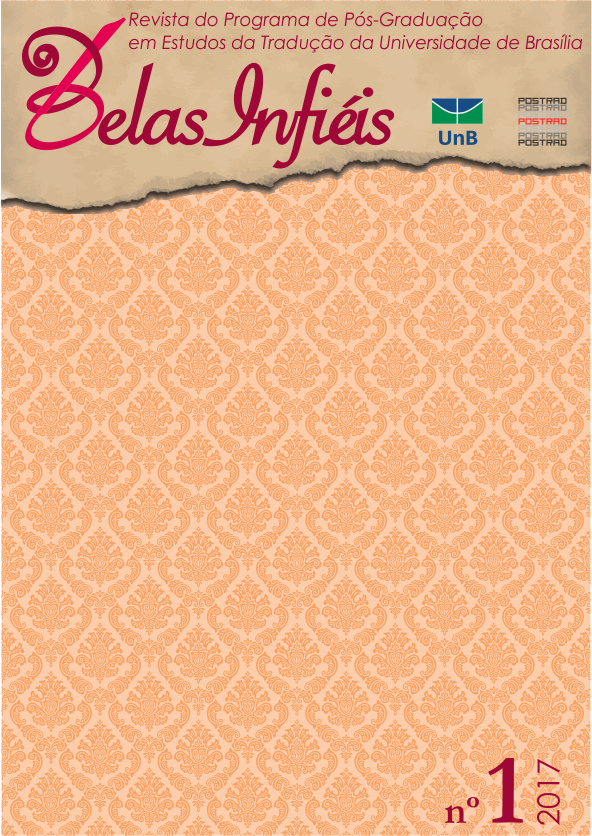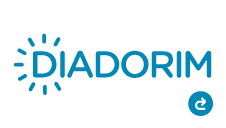A RETRADUÇÃO DE ADVÉRBIOS TERMINADOS EM -MENTE:
UM ESTUDO BASEADO EM UM CORPUS LITERÁRIO NO PAR LINGUÍSTICO ESPANHOL-PORTUGUÊS
DOI :
https://doi.org/10.26512/belasinfieis.v6.n1.2017.11419Mots-clés :
Retradução, Estudos da Tradução baseados em corpora, Advérbios, Espanhol-portuguêsRésumé
Segundo Tahir-Gürçalar (2001), o termo retradução é: i) a ação de traduzir, para uma língua-alvo, um texto de uma língua-fonte que já foi traduzido para aquela mesma língua-alvo; e ii) um texto que já possui uma tradução para uma língua-alvo e é retraduzido para essa mesma língua-alvo. Este artigo, inserido no âmbito disciplinar dos Estudos da Tradução, mais especificamente em sua vertente descritiva, e orientado ao produto tradutório, buscou analisar questões de equivalência funcional referentes à s traduções dos advérbios terminados em -mente. Baseados no estudo de Moraes (2015) e na Hipótese da Retradução (BERMAN, 1990), compilou-se um corpus paralelo bilíngue composto por uma obra literária originalmente escrita em espanhol e duas de suas traduções, uma para o português do Brasil e a outra para o português de Portugal. Os dados quantitativos revelaram que nem sempre a Hipótese da Retradução encontrará respaldo. Observou-se também que nem sempre os advérbios terminados em -mente no texto-fonte são traduzidos por sua forma cognata, corroborando os dados de Moraes (2015).
Références
BAKER, M.; MALMKJAER, K. Routledge Encyclopedia of Translation Studies. 1. ed. Londres: Routledge, 1998.
BERBER SARDINHA, Linguística de corpus. Barueri ”“ SP: Ed. Manole, 2004.
BERMAN, A. La retraduction comme espace de traduction. Palimpsestes, v. 13, 1990, p. 1-7.
CHANUT, M. E. P. A noção de equivalência e sua especificidade na tradução especializada. TradTerm, v. 19, nov, 2012, p. 43-70.
DASTJERDI, H. V.; MOHAMMADI, A. Revisiting “Retranslation Hypothesis”: A Comparative Analysis of Stylistic Features in the Persian Retranslations of Pride and Prejudice. In: Open Journal of Modern Linguistics. V. 3, n. 3, 2013, p. 174 ”“ 181.
DEANE, S. L. Confronting the Retranslation Hypothesis: Flaubert and Sand in the British Literary System. (Tese de Doutorado). Edimburgh: University of Edimburgh, 2011.
DICIO: DICIONÁRIO ONLINE DE PORTUGUÊS. Significado de reimpressão. Disponível em: < ttps://www.dicio.com.br/reimpressao/>. Acesso em: 18 abr 2016.
_____ Significado de finamente. Disponível em: <https://www.dicio.com.br/finamente/>. Acesso em 7 out 2016.
DOMINGOS, L. C.; DA SILVA, I. A L. Tradução e Retradução de The Picture of Dorian Gray, de Oscar Wilde: um estudo de corpus com foco na apresentação do discurso. Domínios da Linguagem, v. 9, n. 2, 2015, p. 150-178.
FALEIROS, A. A crítica da retradução poética. Itinerários ”“ Revista de Literatura, n. 28, 2009, p. 145-158.
GAMBIER, Y. La retraduction, retour et détour. In: Meta v. 39, n 3, 1994, p. 413-417.
_____. La retraduction: ambiguïtés et défis. In: MONTI, E.; SCHNYDER, P. (orgs.) Autour de la retraduction. Paris: Orizons, p. 49-67, 2012.
HALLIDAY, M. A. K; MATHIESSEN, M. I. M. An Introduction to functional Grammar. London: Hoder Arnold, 2004.
HOLMES, J. The name and nature of translation studies. In: VENUTI, L. (ed.) The Translation Studies Reader, 2ª ed., Londres/Nova York: Routledge, p. 180-192, 2004.
MALTA. G; O Processamento Cognitivo em Tarefas de (RE)Tradução: um Estudo Baseado em Rastreamento Ocular, Registro de Teclado e Mouse e Protocolos Retrospectivos; 251 f; Tese (Doutorado) ”“ Faculdade de Letras, da Universidade Federal de Minas Gerais, 2015.
MALTA, G.; RAEL, E. C. As retraduções de La casa de los espíritus: uma (re)visita à Hipótese da Retradução. Letras raras, v. 4, n. 3, 2015, p. 75-97.
MATTOS. T, FALEIROS. A; A noção de retradução nos estudos da tradução: um percurso teórico. Letras raras, v. 03, n. 2, 2014, p. 35-57; Disponível em: <http://revistas.ufcg.edu.br/ch/index.php/RLR/article/view/307/241>; Acesso em: 30 Abr 2016.
MORAES, H. F. R. A questão da equivalência entre os advérbios em -ly e -mente no par de línguas inglês-português: como funciona em linguagem especializada? In: VIANA,V; TANGIN, S E. O (org). Corpora na tradução. São Paulo: HUB editorial, 2015, p. 105-130.
PALOPOSKI, O.; KOSKINEN, A. Revisiting retranslation. In: HANSEN, G.; MALMKJAER, K.; GILE, D. Claims, Changes and Challenges in Translation Studies: Selected contributions from the EST Congress, Amsterdan/Philadelphia: John Benjamins Publishing Company, 2001, p. 27-38.
_____. Reprocessing texts: the fine line between retranslating and revising. In: Across Languages and Cultures 11 (1), 2010 pp. 29”“49.
SUSAN-SARAJEVA, S. Multiple Visa to travelling Theory: Retranslation of literary and cultural theories. In: Target, International Journal of Translations studies, 15 (1), 2003, p. 1-36.
REAL ACADEMIA ESPAÑOLA. Disponível em < http://www.rae.es/>. Acesso em: 15 Out 2016.
TAGNIN, S. E. O.; TEIXEIRA, E. D. British vs. American English, Brazilian vs. European Portuguese: How close or how far apart? ”“ A corpus-driven study. In: Practical Applications in Language and Computers ”“ PALC 2003, 2004, Lodz. Practical Applications in Language and Computers ”“ PALC 2003. Frankfurt am Main: Peter Lang GmbH, v.9, 2004, p. 193-208.
TAHIR-GÜRÇALAR, S. Retranslation. In: BAKER, M.; MALMKJAER, K. Routledge Encyclopedia of Translation Studies. 1. ed. Londres: Routledge, 1998. p. 125-127.
TEIXEIRA, E. D. Tradução culinária e ensino: um exemplo de metodologia de avaliação utilizando etiquetagem e o WordSmith Tools. Domínios de Linguagem, v. 2, n. 2, 2008.
_____. Especificidades da tradução técnica de receitas: alguns problemas e possíveis soluções. TradTerm, v. 15, 2009, p. 173-196.
TOGNINI-BONELLI, E.; MANCA, E. Welcoming children, pets and guests: towards functional equivalence in the languages of ‘agriturismo’ and ‘farmhouse holidays’. TradTerm, v. 10, 2004, p. 295-312.
Téléchargements
Publié
Numéro
Rubrique
Licence
Copyright Statement
Given the public access to this journal, the texts are free to use but requires the recognition of the original authorship and initial publication in this journal to be properly stated.
The journal allows the use of works published for non-commercial purposes, including the right to submit the work to publicly accessible databases. Published contributions are the sole and exclusive responsibility of the author(s).
- When submitting papers to be evaluated by the Belas Infiéis journal, the author(s):
- Declare that the contents of the contributions are original and of their original creation, being entirely responsible for their content if there is an objection by third parties.
- Claim to be aware that they should not commit academic plagiarism.
- Declare that the manuscript has not been published, completely or partially, in Portuguese or another language. If it is a translation it should be submitted to the Translated Articles section.
- Declare that the manuscript is not being evaluated by other journals.
- Declare that the manuscript was not submitted to another journal simultaneously.
- Commit(s) to inform the journal of any kind of error or inaccuracy in their contribution (published, in evaluation or in editing) and to collaborate with the editors to make due corrections of the article (when in evaluation or editing) or erratum/retraction (after publication).
- Declare that there is no conflict of interest regarding the published work.
- Authorize its release if it is accepted for publication without any kind of monetary compensation.
- Agree to assign non-exclusive rights to publication to the magazine, remaining free to make their contribution available in other media as long as the publication of the first version in Belas Infiéis magazine is mentioned. They also authorize Belas Infiéis to assign their texts for reproduction in content indexers, virtual libraries and similar platforms.
- Maintain copyright and grant the journal the right of first publication, the work being licensed under theCreative Commons Attribution License.
- Is/Are allowed and encouraged to publish and distribute their work online after the editorial process, which may increase the impact and citation of the published work.
- Authorize the editorial team to make textual adjustments and to adapt the article to the publication rules, when necessary.



















